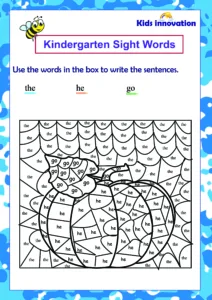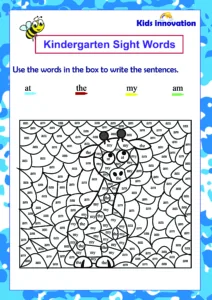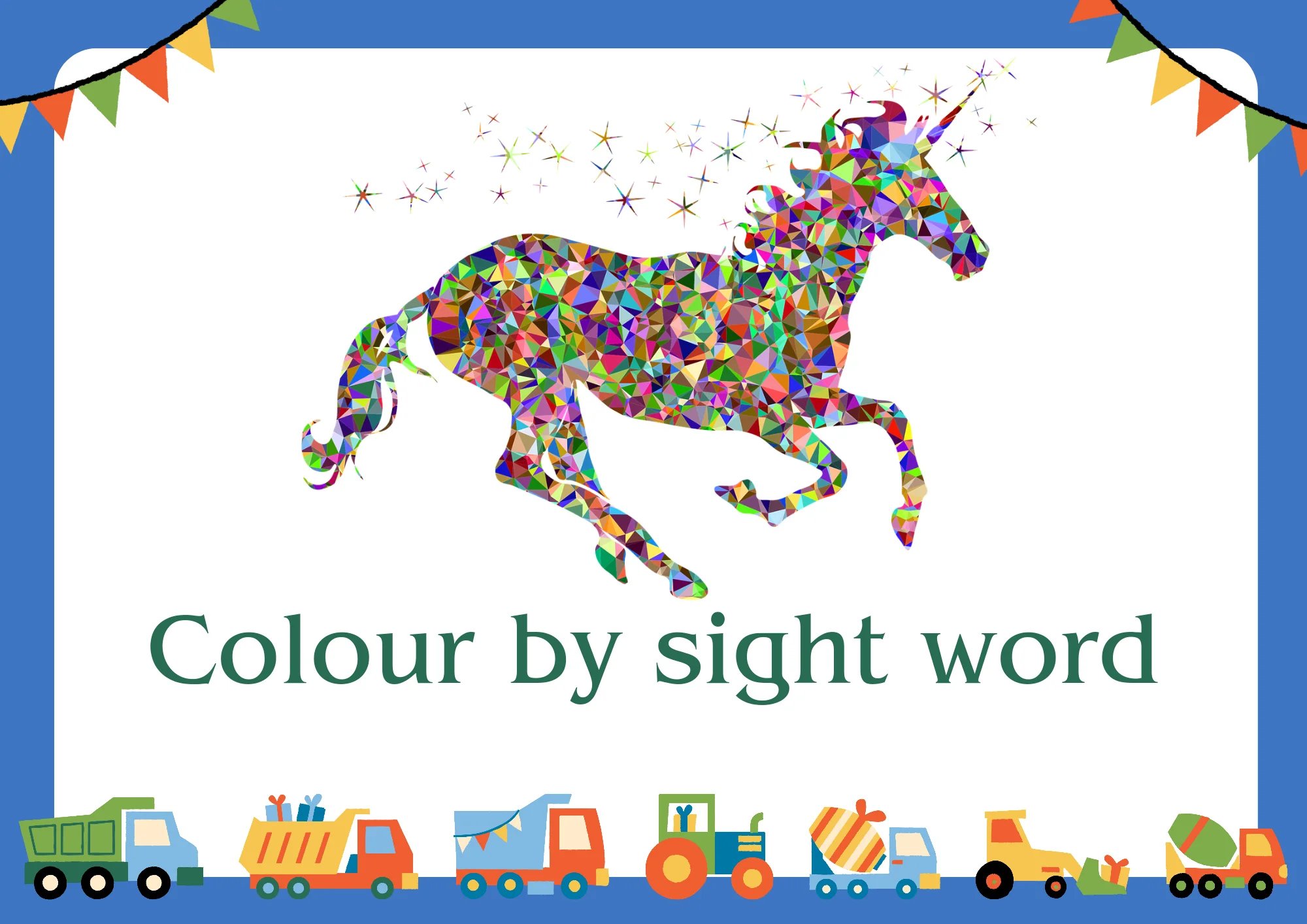Brighten Up Learning: Exploring Color by Sight Word Techniques

Welcome to an exploration of the vibrant world of learning through color by sight words! In this blog post, we’ll delve into the fascinating realm where literacy meets the spectrum of hues, unraveling the effectiveness of color-coded sight words in enhancing language acquisition. Join us on this colorful journey as we uncover the dynamic interplay between words and colors, making the process of learning to read an engaging and visually stimulating experience.
Color plays a crucial role in learning as it can enhance memory, attention, and overall comprehension. Different colors can evoke various emotions, aiding in creating a positive or focused learning environment. Visual stimuli, including color, help engage learners and improve information retention, making educational materials more effective and enjoyable.

free kindergarten tracing & painting worksheets
The Psychology of Color in Learning:
Color-based learning methods are often used in various fields. Some examples include:
Computer Vision: Object recognition based on color is common in computer vision. For instance, identifying ripe fruits in agriculture or detecting specific colored objects in industrial settings.
Medical Imaging: In medical diagnostics, color-based segmentation helps highlight specific tissues or anomalies in images, aiding in the identification of diseases.
Robotics: Robots use color-based cues for navigation and object manipulation. For instance, sorting objects on a conveyor belt based on color.
Education: Color-coded materials can enhance learning experiences, especially for young children. Educational tools often use colors to differentiate concepts or highlight important information.
Web Design: User interfaces often leverage color to convey information or guide user interactions. Successful websites use color psychology to create a positive user experience.
Quality Control: Color-based inspection is crucial in industries like manufacturing, where products must meet specific color standards for quality control.
Accessibility: Color-based cues are used in designing accessible environments, such as color-coded signage for people with visual impairments.
These examples showcase the versatility of color-based learning methods across various domains.
Understanding Sight Words:
“Sight words” refer to common words that are recognized immediately upon sight, without the need for decoding. These words often don’t follow regular spelling rules, so they’re typically taught by memorization. Understanding sight words is crucial for early reading, as they form a foundation for recognizing and comprehending more complex text. Teachers often focus on these words to enhance reading fluency and overall reading proficiency in young learners.

Sight word recognition is crucial in early education because it forms the foundation for fluent reading. Mastering common, frequently used words by sight helps children read more quickly and comprehend sentences better. This skill accelerates overall reading development and enhances a child’s confidence in tackling more complex texts.
OverallGuides.com provides exclusive worksheets for kids, available for free download in printable PDF format.
kindergarten
Color by Sight Word Techniques:

Coloring by sight words can be a fun and effective way to reinforce word recognition. Use different colors for each word, create color-coded word lists, or incorporate themed coloring pages for added engagement.
The Color by Sight Word approach is an educational method that involves associating specific colors with sight words to help enhance memorization and recognition skills in early readers. Sight words are common words that are often challenging to sound out, so visual memorization is crucial.

In this approach, each sight word is assigned a specific color. For example, the word “the” might be associated with the color red. Children then color or highlight the sight words with their corresponding colors in reading materials or worksheets. This visual reinforcement aims to create a strong connection between the word and its color, making it easier for children to recall and identify the words when reading.
This method leverages the visual memory and helps make the learning process more engaging for young learners. It’s often used as a supplementary strategy in early literacy programs to support reading fluency and word recognition.
Incorporating color into sight word learning can enhance visual engagement and memory retention for learners.
Facilitate Visual Recognition: Associating each sight word with a distinct color aids in visual recognition, making it easier for learners to distinguish and remember words.
Stimulate Memory: Colors can trigger memory recall, helping learners remember sight words more effectively by linking them to visual cues.
Capture Attention: Bright and contrasting colors capture attention, promoting focus and interest during the learning process.
Cognitive Association: Connecting words with specific colors creates cognitive associations, reinforcing the learning experience and making it more enjoyable.
Enhance Multisensory Learning: Adding color introduces a multisensory element, engaging both visual and cognitive aspects of learning, which can be particularly beneficial for different learning styles.
Facilitate Organization: Color-coding words or grouping them by categories can help learners organize and categorize information, fostering a systematic approach to learning.
Boost Motivation: The use of vibrant colors can create a positive and stimulating learning environment, boosting motivation and enthusiasm for acquiring sight word proficiency.
Support Literacy Development: Visual aids, such as colored sight words, can contribute to early literacy development by reinforcing word recognition skills in a more visually appealing manner.
Remember, the effectiveness of incorporating color may vary among individuals, so it’s essential to consider the preferences and needs of the learners.
Color by Sight Word is a popular educational activity to reinforce sight word recognition in a fun way. Here are a few effective techniques:
Color Coding: Assign a specific color to each sight word. For example, the word “and” could always be colored blue. This visual association helps reinforce the connection between the word and its meaning.
Create Patterns: Incorporate patterns within the coloring sheet. For instance, use a rainbow pattern for different sight words. This adds an extra layer of engagement and makes the activity visually stimulating.
Incorporate Images: Include simple images that relate to the sight words. For instance, if the sight word is “sun,” have a sun-shaped space to color. This helps reinforce the meaning of the word through both visual and linguistic cues.
Use Multisensory Elements: Allow children to use different art supplies, such as colored pencils, markers, or crayons. This multisensory approach enhances the learning experience and caters to various learning preferences.
Progressive Difficulty: Design sheets with varying difficulty levels. Start with basic sight words and gradually introduce more challenging ones. This ensures a gradual learning curve and helps build confidence.
Interactive Games: Turn the activity into a game by incorporating challenges or a timer. This adds an element of competition and excitement, motivating children to complete the task.
Word Sentences: Instead of single words, incorporate short sentences with sight words. This helps children understand how sight words function within the context of a sentence.
Themed Coloring Sheets: Create coloring sheets based on specific themes or seasons. For instance, use Halloween-themed words and images during October. This makes the activity more engaging and relevant.
Remember, the key is to make learning enjoyable and interactive, fostering a positive association with sight words.
Letter Tracing Worksheets sample From Overall Guides
letter tracing worksheets
Implementing Color by Sight Word in Education:
Implementing Color by Sight Word in education involves associating specific sight words with distinct colors to enhance learning through visual cues. For example, assign the word “the” to the color blue. Use coloring activities, flashcards, or interactive games where students identify and color words based on their corresponding colors. This method can aid in memorization and make learning sight words more engaging for students.
Practical tips for teachers and parents Effective Communication: Maintain open communication between teachers and parents to ensure a supportive learning environment for the child.
Consistent Routine: Establish a consistent routine for children, both at school and at home, to provide stability and help them focus better.
Encourage Reading: Foster a love for reading by providing a variety of age-appropriate books and setting aside time for reading each day.
Set Realistic Goals: Work together to set achievable academic and behavioral goals for the child, promoting a sense of accomplishment.
Active Listening: Practice active listening to understand the child’s needs, concerns, and progress both in the classroom and at home.
Create a Learning Environment: Set up a dedicated, organized, and quiet space at home for homework and studying to enhance the child’s concentration.
Positive Reinforcement: Use positive reinforcement to motivate and reward good behavior and academic achievements.
Collaborative Problem-Solving: When issues arise, approach problem-solving collaboratively, involving both teachers and parents to find effective solutions.
Technology Balance: Encourage a balanced approach to screen time, ensuring children have a healthy mix of educational and recreational activities.
Model Lifelong Learning: Demonstrate a positive attitude towards learning, showcasing that education is a lifelong journey for both parents and teachers.
Remember, a collaborative and supportive partnership between teachers and parents greatly contributes to a child’s overall development.
Color by Sight Word activities can be a fun and engaging way for learners to practice sight word recognition.
Themed Coloring Sheets:
Create coloring sheets with a theme, such as animals, seasons, or holidays. Incorporate sight words into the images or instructions to add an extra layer of learning.
Interactive Games:
Turn sight word coloring into a game. Create a game board with different sight words, and each word corresponds to a specific color. As learners correctly identify the words, they can color in the corresponding spaces on the board.
Story-based Coloring:
Develop a short story or sentence using sight words. Each sight word can be associated with a particular color, and as learners read the story, they color the illustrations accordingly.
Technology Integration:
Explore digital coloring apps or websites where students can color by sight word on a tablet or computer. This adds a tech-savvy dimension to the activity.
Collaborative Coloring Mural:
Create a large mural by assigning different sight words to individual students or groups. As they correctly identify and color their assigned words, piece the mural together for a collaborative masterpiece.
Outdoor Learning:
Take the coloring activity outdoors. Use chalk on pavement to write sight words, and have learners color them in with sidewalk chalk or colored water.
Musical Sight Word Coloring:
Play music and have students move around the room. When the music stops, they have to color the sight word nearest to them. This adds a dynamic and energetic element to the activity.
Mystery Picture Coloring:
Create mystery pictures where sight words are hidden within a larger image. As students correctly identify and color the sight words, the hidden picture is revealed.
Resources:
Teachers Pay Teachers: This platform often has a variety of Color by Sight Word resources created by educators.
Remember to adapt these activities based on the age and skill level of the learners.
Potential obstacles in implementing Color by Sight Word in Education:
Implementing “Color by Sight Word” activities may face challenges such as:
Word Complexity: Some sight words may be more complex or abstract, making it challenging for young learners to associate them with specific colors.
Color Perception: Consideration of color blindness and ensuring that the chosen colors are easily distinguishable by all students.
Individual Differences: Students may have varying levels of proficiency in recognizing sight words, requiring adaptable activities to cater to different learning paces.
Resource Availability: Availability of materials for coloring activities and ensuring they are cost-effective and easily accessible.
Engagement Levels: Maintaining student interest and engagement over time, as repetitive tasks might lead to disinterest.
Cultural Sensitivity: Awareness of cultural differences in color associations to avoid unintentional misunderstandings or biases.
Inclusive Design: Ensuring that the activities are inclusive and accessible for students with diverse needs, including those with learning disabilities.
Teacher Training: Providing adequate training for educators to effectively implement and manage “Color by Sight Word” activities in the classroom.
Addressing these obstacles will contribute to the successful implementation of Color by Sight Word programs in an educational setting.
Success stories of schools or individuals using Color by Sight Word:
Color by Sight Word activities can be effective in helping individuals, especially young learners, develop and reinforce their sight word recognition skills. While I don’t have specific success stories about schools or individuals using Color by Sight Word, many educators have reported positive outcomes with such activities.
Teachers often find that incorporating visual and hands-on elements, like coloring, enhances engagement and retention of sight words. Students can enjoy the creative aspect of coloring while simultaneously reinforcing their sight word knowledge.
For specific success stories, you might want to check educational forums, blogs, or teacher communities where educators share their experiences and best practices. Additionally, reaching out to local schools or teachers who use this method could provide valuable insights into its effectiveness in different educational settings.
Conclusion:
Color by Sight Word activities offer several benefits, including.
1.Reading Reinforcement
2.Visual Discrimination
3.Fine Motor Skills
4.Creativity and Engagement
5.Repetition and Memorization
6.Self-Esteem Boost
7.Independent Learning
8.Versatility
Overall, incorporating these activities into educational practices supports holistic development in young learners.
For more color by sight word worksheets from Shutterstock click here
https://www.shutterstock.com/search/color-by-sight-word
 Skip to content
Skip to content 